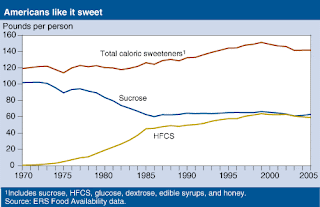For instance, take a look at this Girard's Raspberry Salad Dressing. What is the first ingredient listed? HFCS! This means that this salad dressing has more HFCS than it has oil or water!!! Basically, you're drinking straight High Fructose Corn Syrup out of this bottle! That's crazy!
You may or may not know that HFCS was created in a laboratory back in 1957. Then someone else figured out how to produce it in large quantities in or around 1965. [ Basically, they take corn and extract Corn Starch. From Corn Starch they get Corn Syrup. Then they add enzymes, caustic soda, and other ingredients and produce a NEW SYRUP that is 42% fructose (HFCS 42). Then after further laboratory work, then get HFCS that is 90% fructose (HFCS 90, which is used in baked goods). Finally, they mix these two to get HFCS 55, which is used in soft drinks ].
HFCS is twice as sweet as table sugar. But the main problem is that high fructose tricks you body into thinking that it's still hungry. So, you keep eating. In fact, with HFCS your body never feels quite full. And because HFCS messes with your hormone balance, the result is that we are not only eating more calories, but the body begins to store more of those calories as fat.
HFCS began creeping into the American diet in 1975. Mysteriously enough, tariffs on sugar and sugar quotes were passed by our government in 1977. This placed limits on how much sugar we could produce as a country, and made imported sugar more expensive for food companies to purchase! Therefore, HFCS became the cheaper alternative.
Other countries, including MEXICO, still use table sugar in soft drinks. In fact, some of my friends go to buy soda at Mexican stores, because the same product is made with sugar, and not with HFCS! Take a look at the label:
Today, Americans consume an average of 65 lbs. of HFCS per year. In addition, our annual use of all sweeteners has increased from an average of 120 lbs. per person, to over 140 lbs. per person!
Now for the main question: Is eating HFCS really worse than eating Table Sugar? You betcha. HFCS is perhaps the most unhealthy, laboratory-produced chemical, that we have ever created. Its use is illegal in some countries, but we love to sell it and eat it here in the United States.
HFCS contributes to obesity, diabetes, cardiovascular disease, and to fatty liver disease. Plus, the Institute for Agriculture and Trade Policy found traces of MERCURY in nearly 50 percent of tested samples of commercial high fructose corn syrup (HFCS). A separate study by the same Institute detected mercury in nearly one-third of 55 popular brand- name food and beverage products where HFCS was the first or second ingredient—including products by Quaker, Hershey’s, Kraft and Smucker’s.
My wife and I went to Alberta, Canada a couple of years ago, and we were surprised to find that the same name-brand food products on the shelf are made in Canada without HFCS! These foods included jams, candy bars, and soft drinks.
So, now we read ALL nutrition labels and AVOID anything made with HFCS or with "Corn Sugar," as they are starting to call it. We also watch our total sugar intake.
The bottom line is that I'll take table sugar any day over HFCS or any other artificial sweetener. There is nothing "natural" or "fresh" about HFCS. I recommend that you stay away from any sweetener made in a laboratory. That stuff will kill you in the long run.
I prefer to eat NATURAL FOODS. I prefer to eat FRESH. That's why I became a "Freshetarian."
Become a Freshetarian. Feel Better. Live Longer.












